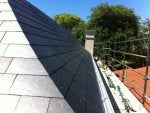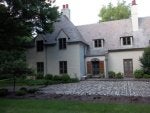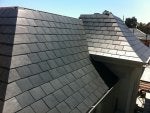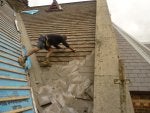Here's a cool old slate roof that I'm gonna restore. She's pretty original and has had some crappy repairs over the years. The house was built in 1851... that's only 10 years after Melbourne itself was founded. If I'm not mistaken before the American Civil War even. Should be real interesting to see whats under the roof and the construction etc..

Here's a cool old slate roof
spinsy
21 - 40 of 102 Posts
Found these pics with the above one... another turretty hip end with a quickish curve. St Andrews church Melbourne.... about 1985 I think, can't remember the slate... my memory is starting to go I think
Attachments
-
200.3 KB Views: 586
that's cool- there is a church near me with a curve like that- it's done in that dull green closed shingle I was showing you.
stephen
stephen
You two could post as many pictures of old tile roofs as you wish. There is not many around our area that do repairs on these types of properties and so many have switched over to asphalt shingles. I do really enjoy seeing your guys work.
Not sure if any of you guys are interested.. and just tell me if you are'nt. About 90% of newly constructed homes in the affluent suburbs of Melbourne that get slate roofs are at present built like these pics. They are trying to copy the old French Rennaisance style homes in France. Just finished this one. I don't like webbing the slates for mitres but we just can't get wide mitre slates and I think it looks better than closer soldiers or tabs or whatever you call em
Attachments
-
59.7 KB Views: 741
-
76 KB Views: 470
-
68.9 KB Views: 468
not a lot of NEW slate done here in my area.
Some--- but not much.
whether the hips are mitered--- depends on the style---- Tudors and period French roofs usually have miters----- colonial etc. will have copper or steel ridge roll here.
the Tudor style was HUGELY popular here in the 1920's----- I would say over 60% of the slate roofs we work on are Tudors----- French style is much more rare.
Here is one we worked on this past summer.....
Some--- but not much.
whether the hips are mitered--- depends on the style---- Tudors and period French roofs usually have miters----- colonial etc. will have copper or steel ridge roll here.
the Tudor style was HUGELY popular here in the 1920's----- I would say over 60% of the slate roofs we work on are Tudors----- French style is much more rare.
Here is one we worked on this past summer.....
Attachments
-
96.5 KB Views: 479
-
96 KB Views: 580
Spinsey--- I notice that slate was a dark grey/ black ???????
I don't see that at all here.--- I am guessing it comes from spain??? China?????
we also wouldn't find the hips face nailed like that- the fastners would be concealed--- but we often find a dab of mastic under the hip slate to stop wind uplift. when we re-do them, we typically flash every course---- but what we find was originally done in the 1920's is they just butted the miter slates together- over time the miters spread and open-and then the gap gets caulked, and re-caulked, and recaulked..............
I don't see that at all here.--- I am guessing it comes from spain??? China?????
we also wouldn't find the hips face nailed like that- the fastners would be concealed--- but we often find a dab of mastic under the hip slate to stop wind uplift. when we re-do them, we typically flash every course---- but what we find was originally done in the 1920's is they just butted the miter slates together- over time the miters spread and open-and then the gap gets caulked, and re-caulked, and recaulked..............
I put this picture in to show color.
in the lower right area of the picture there are some greenish slates hanging on stainless steel hooks??????
prior to our involvement with this roof, previous contractors had done repairs using NEW slate.
that color is semi weathering vermont grey green. In person , it's a bit greener.
As it ages the semi weathering designation---will turn more grey,buff tan--- like the rest of the roof-- but that will take many decades.--- we typically use salvaged slate for repairs--- so the repairs are invisible when we are done.
In the 1920's the a couple of slates were used---never fading sea green---and semi weathering sea green. those colors are not really available new anymore--- and the grey green color is the closest match, currently.
the sea green colors are/were a superior color in my opinion---- a bit brighter green and slightly more pea soup color--- definitely a "SEA" green.
the never fading sea green was also a harder slate, though not as fine grained. we find it around on roofs quite frequently--- but now a days it usually has a blacker appearance from soot in the air in the 20's-70's ( steel mills, coal dust etc.)
stephen
in the lower right area of the picture there are some greenish slates hanging on stainless steel hooks??????
prior to our involvement with this roof, previous contractors had done repairs using NEW slate.
that color is semi weathering vermont grey green. In person , it's a bit greener.
As it ages the semi weathering designation---will turn more grey,buff tan--- like the rest of the roof-- but that will take many decades.--- we typically use salvaged slate for repairs--- so the repairs are invisible when we are done.
In the 1920's the a couple of slates were used---never fading sea green---and semi weathering sea green. those colors are not really available new anymore--- and the grey green color is the closest match, currently.
the sea green colors are/were a superior color in my opinion---- a bit brighter green and slightly more pea soup color--- definitely a "SEA" green.
the never fading sea green was also a harder slate, though not as fine grained. we find it around on roofs quite frequently--- but now a days it usually has a blacker appearance from soot in the air in the 20's-70's ( steel mills, coal dust etc.)
stephen
Attachments
-
104.9 KB Views: 412
Yeah, I'm not a fan of the face nailing... they are gal screws actually, but the slates come holed for a gauge of 225 mm so the slates being 250 mm wide only leaves 25mm to try to conceal the nails.... it's really not stong enough secure them satisfactorily so they get screwed through the face. Bugger all lap for that slate too. It never causes any problems but looks crap. If you look closely you see the grain of the mitre slates running the opposite way. Its ugly but they wont bring in the wide mitre slates. Its hard enough getting a few unholed slates for the mitres so you don't have a hole in the bottom edge. It's not good but nobody here ever says anything I don't know why. The slate is Spanish del carmen ultra.. 100 year guarantee from the quarry. Each course is fashed with fish tail flashing
Attachments
-
203 KB Views: 1,545
I've got some interesting pics and info about a job i looked at today but I'll put em up tomrrow.. I gotta go to bed and although I'm on holidays its midnight Wednesday here and I'm knackered. Here's a dragon head shell end or hip starter you call em I think.
Attachments
-
201 KB Views: 331
Stephen, forgot to mention that's a cool looking house in those pics you posted the slates look real chunky with a distinctive spalled edge... nice I like them like that.
Yes--- I see it now---- your hip slates are really just field slates laying on edge.Yeah, I'm not a fan of the face nailing... they are gal screws actually, but the slates come holed for a gauge of 225 mm so the slates being 250 mm wide only leaves 25mm to try to conceal the nails.... it's really not stong enough secure them satisfactorily so they get screwed through the face. Bugger all lap for that slate too. It never causes any problems but looks crap. If you look closely you see the grain of the mitre slates running the opposite way. Its ugly but they wont bring in the wide mitre slates. Its hard enough getting a few unholed slates for the mitres so you don't have a hole in the bottom edge. It's not good but nobody here ever says anything I don't know why. The slate is Spanish del carmen ultra.. 100 year guarantee from the quarry. Each course is fashed with fish tail flashing
you really kind of NEED those screws to hold down the bottom edge of the slate since the slate in that position is not tall enough for the top edge to rest on the deck..
those slates look kind of wide---- here we would call it "barn slate"--- 12-14 inches wide for the field slate. we can get the slates punched or unpunched---and usually in a residential setting the slates are a bit smaller---more in scale with the house---- normally not more than 10 inches wide.
usually we would use maybe a 10 inch wide slate---and adjust the layout a little closer to the hip so that a 14 inch wide slate will work for the hip miter.
sometimes the lower corner of each slate at the hip will be clipped off to avoid that fragile point.
edit:--- if that fragile point is clipped off, we call that "fan tail"--- I don't know why.
the harder the slate the more of a spalled edge you get when we cut them.Stephen, forgot to mention that's a cool looking house in those pics you posted the slates look real chunky with a distinctive spalled edge... nice I like them like that.
the thicker the cut the more of a spalled bevel we get also.
the salvaged slates we use are usually older and a bit softer- so when they are cut the bevel is a bit narrower. We don't usually DO anything about that--- some times we will dress it up a bit with the shank of the slate hammer. most of those slates are 3/16"----- we get more of a cut bevel in 1/4" or thicker sizes.
Stephen
In my area all of the old houses with mitered hip slates are clipped off at the corner and I always wondered why, thank you.Yes--- I see it now---- your hip slates are really just field slates laying on edge.
you really kind of NEED those screws to hold down the bottom edge of the slate since the slate in that position is not tall enough for the top edge to rest on the deck..
those slates look kind of wide---- here we would call it "barn slate"--- 12-14 inches wide for the field slate. we can get the slates punched or unpunched---and usually in a residential setting the slates are a bit smaller---more in scale with the house---- normally not more than 10 inches wide.
usually we would use maybe a 10 inch wide slate---and adjust the layout a little closer to the hip so that a 14 inch wide slate will work for the hip miter.
sometimes the lower corner of each slate at the hip will be clipped off to avoid that fragile point.
edit:--- if that fragile point is clipped off, we call that "fan tail"--- I don't know why.
Now I get to sound smarter then I am if it ever comes up.
Stephen- and anyone else whose interested- here's a roof I looked at yesterday to do a restoration on. This roof is unusual here in Melbourne and maybe anywhere as it has a couple of strange things going on... all completely original from when first installed I would say around 1880. This house is typical for the era in every way except for the slates on the roof. Firstly, the slates on the roof are three different sizes.. we very ocassionally see two different sizes very close to each other and they are commonly [ i'm gunna speak imperial for you guys cause that's what you use i think ] 20x10 inches, and a couple other sizes close that but larger and smaller. The smallest you very seldom see here are 16x10 and the largest- perhaps seen marginally more than the 16's is 24x12 inches. Other sizes randomly seen between this are 18x9,18x10,20x12,22x11 and 22x12. This particular roof had sizes 16x10, 14x8 and 12x10 inches and all completely original. The 16x10 are pretty rare but I have never seen 14x8 or 12x10 on any other roofs in my 36 odd years on slate roofs. The other odd thing about this roof is one half of the roof is Penryhn purple slate and the other half is Bangor blue slate. 16x10 and 12x10 Penryhns and 14x8 Bangors. Although today from pollution they are almost the same color... when first installed would have been very easy to see difference. My old mentor used to call 16,s peggy slates even though he knew they wernt really and he just liked to call em peggies cause they were the smallest ones in Melbourne. They are really" Ladies " though. But the 12x10 really is a double and is classed as a real peggy slate. First real ones I've ever seen. Not sure if you know what I'm talking about here ... it's real old English stuff and since the old blokes gone I've never really had to think about it cause no-one here ever talks about it. Good to reminisce though even if it was with myself:laughing:
Attachments
-
107.5 KB Views: 421
-
97.3 KB Views: 390
-
93.7 KB Views: 425
couple more pics of that odd roof
Attachments
-
77.4 KB Views: 499
-
83.3 KB Views: 443
-
85.5 KB Views: 471
We were supposed to be on holidays but we were needed. Sparkys needed acess to the upper ceiling cavity and it couldn't wait a couple more days. Couple pics from today
Forgot to upload:whistling
Another go
Attachments
-
79.2 KB Views: 409
-
106.7 KB Views: 446
-
105.9 KB Views: 437
couple more
Attachments
-
116 KB Views: 412
-
108 KB Views: 414
-
115.8 KB Views: 405
Last couple
Attachments
-
106.1 KB Views: 420
-
103.3 KB Views: 386
-
103.3 KB Views: 404
21 - 40 of 102 Posts
-
?
-
?
-
?
-
?
-
?
-
?
-
?
-
?
-
?
-
?
-
?
-
?
-
?
-
?
-
?
-
?
-
?
-
?
-
?
-
?
- posts
- 3.6M
- members
- 169K
- Since
- 2003
A forum community dedicated to professional construction and remodeling contractors. Come join the discussion about the industry, trades, safety, projects, finishing, tools, machinery, styles, scales, reviews, accessories, classifieds, and more!
Explore Our Forums



























